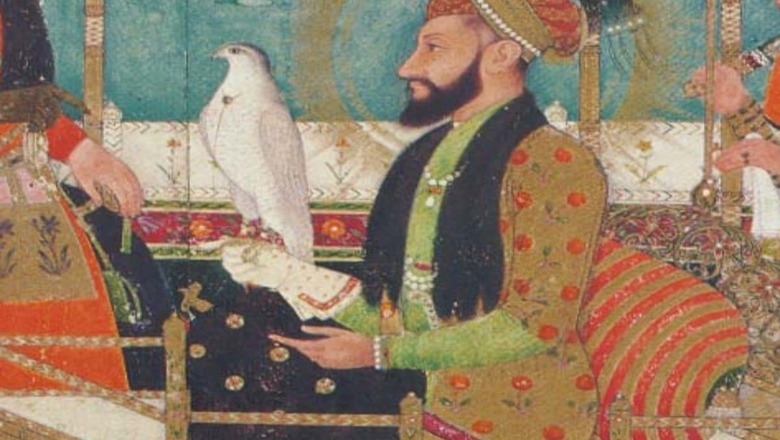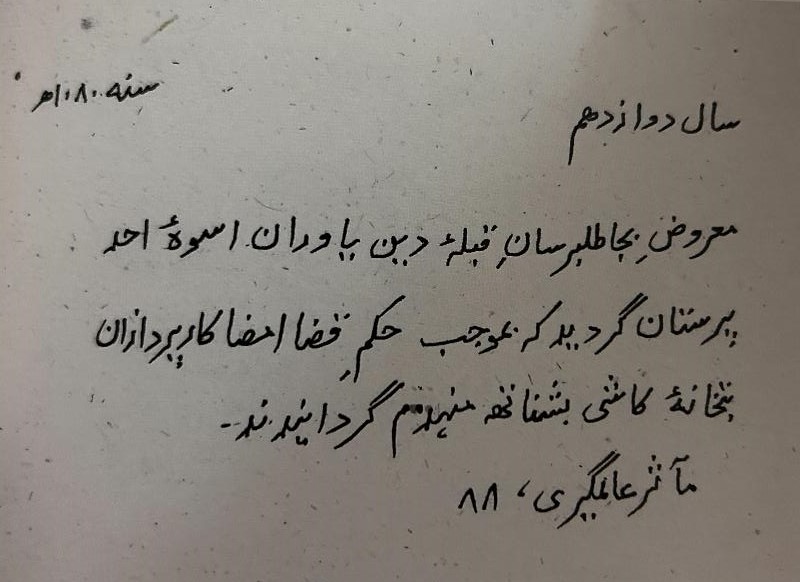
views
The controversy revolving around Aurangzeb is an old and seemingly unending one. The same old lines that Aurangzeb was not cruel and did not destroy temples were again repeated recently during the Gyan Vapi case in the Varanasi court, despite historical records clearly stating exactly the opposite. Keeping in mind the constant insistence of the white-left-Islamist “academicians” that Aurangzeb was not a bigot, in this article, I will look at the nature of the Muslim state, and religious policies of Aurangzeb (which were based on the Muslim state theory) to find if there was any scope for tolerance and secularism in his rulings and policies.
The Muslim State: Its Theory and Character
A Muslim state from its basic ideology of origin is a theocracy, where God is the true king, and the rulers are mere agents who are bound to enforce his law on all. Thus, the ruler, his court, and all civil authorities exist only to spread and enforce the true faith of the true king. Under such an ideology, a state will view infidelity as equal to treason, because the non-believer or kafir does not acknowledge the authority of the true king and instead worships false deities.
Thus, tolerating any sect outside orthodox Islam is almost equivalent to committing a sin, and the worst sin is polytheism. Islamic theology, therefore, tells the true believer that his highest duty is to make ‘exertion (jihad) in the path of God’ by waging war against infidel lands (dar-u-harb) till they become a part of the realm of Islam (dar-ul-Islam), and their populations convert into true believers. After the conquest, the entire infidel population becomes slaves of the conquering army (Jihad fi sabih ullah -Quran, ix. 29; For “Jihad” read Hughes, 243-248, 710: Encyclopaedia of Islam, i, 1041).
The conversion of the entire population to Islam and the extinction of every form of dissent is the basic ideology of the Muslim state. If any infidel still exists in the community, it is seen as a necessary evil, and it must be so for a short period only. Political and social disabilities must be imposed on him and bribes offered to him from the public funds to hasten the day of his spiritual enlightenment and the addition of his to the role of true believer (ref: Jadunath Sarkar, ‘A Short History of Aurangzeb’).
A non-Muslim thus cannot be a citizen of a Muslim state; he is a member of a depressed class, and his status is at par with a slave. He lives under a contract known as zimma with the state; and for the life and property being spared to him, he must face political and social disabilities, and pay a commutation money known as jizya. He must also pay a tax for his land (kharaj), pay for the maintenance of the army in which he cannot enlist, and he must show humility in dress and behaviour that he belongs to a subject class (non-Muslims cannot wear fine dresses, ride on horseback or carry arms; he must behave respectfully and submissively to all Muslims) [Encyclopaedia of Islam, I, 917 ~ dar-ul-harb].
As the learned Qazi Mughis-ud-din had advised Alauddin Khalji in accordance with the teaching of the books on Canon Law: “By these acts of degradation are shown the extreme obedience of the zimmi, the glorification of the true faith of Islam, and the abasement of true faith…according to all other theologians, the rule for Hindus is ‘Either Islam or death’” (Sarkar, 119). The zimmi is under certain legal disabilities with regard to testimony in the law courts, protection under the criminal law, and marriage. The Muslim state guarantees him security of life and property and protection in the exercise of his religion as long as he doesn’t build new temples, and does not carry out any offensive publicity while exercising his faith.
During Islamic rule in the Indian subcontinent, in addition to the poll tax and public degradation of dress and demeanour imposed on them, the non-Muslims were subjected to various hopes and fears. Rewards in the form of money and public employment were offered to converts from Hinduism. The Hindu leaders were systematically repressed, to deprive the sect of spiritual instruction, and their religious gatherings and processions were forbidden to prevent the growth of solidarity and a sense of communal bonding among them. Besides the destruction of temples, no new temples were allowed to be built nor any old ones to be repaired, so the total disappearance of all places of Hindu worship was merely a matter of time (Sarkar, 119).
The destruction of temples, the slaughter of Hindus, and every other war of aggression were sanctified as ‘jihad’. Thus, a mind frame was created within the Muslim community, which habitually regarded plunder and homicide as the purest of human acts as ‘exertion (jihad) in the path of God.’ The murder of infidels (kafir- kushi) is counted as a merit in a Muslim; an act in itself that would raise his soul to heaven (Sarkar, 120).
The settled principle of Islam ended by making the Muslims a privileged class, nourished on state bounties, and naturally prone to indolence. Public office is regarded as the birthright of the faithful, and vast sums spent by the state in maintaining pauper houses and in scattering alms during Ramzan and other holy days and other ceremonies, became a direct premium on laziness, creating a lazy and pampered Muslim class within the Islamic empire. Such is the ideal of the Muslim state as theorised and perceived by Islam.
Aurangzeb’s Bigotry and Temple Destruction
Aurangzeb began his attack on Hinduism in a gradual manner. In the first year of his reign, in a charter granted to a priest of Banaras, he declared that his religion forbade him to allow the building of new temples. During his viceroyalty of Gujarat (1644), he destroyed the Chintamani Parshvanath Jain temple and slaughtered a cow inside its premises. He later converted it into a mosque. He had at that time also demolished many Hindu temples in the province. An order was issued early in his reign in which all local officers of Odisha were called upon to pull down all temples, built during the last 10 or 12 years, and to allow no old temple to be repaired.


Next, on April 9, 1669, he issued a general order to demolish all the schools and temples of the infidels and to put down their religious teachings and practices (ref: Sarkar, ‘History of Aurangzeb,’ volume III, appendix 5). His destroying hand then fell on the famous Hindu temples, such as the second temple of Somnath, the Vishwanath temple of Banaras, and the Keshav Rai temple of Mathura.

The holy city of Mathura has always been a special victim of Muslim bigotry. It stood on the king’s highway between Agra and Delhi. Aurangzeb appointed a ‘religious man’, Abdun Nabi, as faujdar of Mathura, to subjugate the Hindus. On October 14, 1666, learning that there was a stone railing in the temple of Keshav Rai, which Dara Shukoh had presented to it, Aurangzeb ordered it to be removed. Finally, in January 1670, he sent orders to completely destroy the temple and change the name of the city to Islamabad. The destruction of Hindu places of worship was one of the chief duties of the Muhtasibs or Censors of Morals who were appointed in all the sub-divisions and cities of the empire. In June 1680, the temples of Amer, the capital of the loyal State of Jaipur, were broken down. In 1674, he confiscated all the lands held by Hindus as religious grants (wazifa) in Gujarat.
As already mentioned before, to live in an Islamic state, the unbeliever has to pay a tax called jizya, and the tax should be paid in humility (Quran, ix. 29). The tax was thus levied by Muslim rulers in a manner humiliating to the taxpayers: the taxed person had to come on foot and make the payment standing, while the receiver would be seated. Women, children below fourteen. and slaves were exempted from the tax; blind men, cripples and lunatics paid only when they were wealthy; monks were untaxed if they were poor, but if they belonged to rich monasteries, the heads of these religious houses had to pay. The impost was not proportioned to a man’s actual income, but the assesses were roughly divided into three classes as their property was estimated at not more than 200 dirhams (the poor), between 200 and 10,000 dirhams (the middle class), and above 10,000 (the rich). Money changers, cloth dealers, landowners, and physicians were placed in the rich class, while tailors, dyers, cobblers, and shoe-makers were counted as poor. This last class paid only when their professional income left a margin above the cost of maintaining themselves and their families. Beggars and paupers naturally escaped the tax. The rates of taxation were fixed at 12, 24 and 48 dirhams a year, and the poorest were hit the hardest by the jizya.
Aurangzeb gave orders in which the jizya was imposed on the ‘unbelievers’ in all parts of the empire from April 2, 1679, and as the official historian recorded, it was done to “spread Islam and put down the practice of infidelity.” The Hindus of Delhi gathered together and asked for the withdrawal of the jizya, but Aurangzeb turned a deaf ear to them. Next Friday, the whole road from the gate of the Red Fort to the Jama Masjid was blocked by a crowd of Hindu protestors. They did not disperse despite a warning; and Aurangzeb, after waiting vainly for an hour to go to the public prayer, ordered elephants to be driven through the mass of men, trampling them down and clearing a way for him (Sarkar, 125).
The jizya yielded a huge revenue. In Gujarat, for instance, it was Rs 5 lakh a year; the jizya meant for the Hindus an addition of one-third to every subject’s direct contribution to the state; while a Muslim remained free from this tax. The officially avowed policy in imposing the jizya was to increase the number of Muslims by putting pressure on the Hindus. As Manucci noted, “Many Hindus who were unable to pay turned Muhammadan, to obtain relief from the insults of the collectors… Aurangzeb rejoices.”
Besides the religious jizya tax, by an ordinance issued on April 10, 1665, the mahsul (custom duty) on all commodities brought in for sale was fixed at two and a half per cent of the value for Muslims and 5 per cent for Hindu vendors. On May 9, 1667, Aurangzeb abolished the custom duty for Muslim traders, while for the Hindus, it was retained at the old rates. The third instrument of the policy of putting economic pressure on Hindus was the granting of rewards to converts and the offering of posts in the public service, freedom from prison, or succession of disputed property, on condition of turning Muslim.
In 1671, an ordinance was issued that the rent collectors of the Mughal kingdom must be all Muslims and the viceroys and taligdars were ordered to remove their Hindu head clerks (peshkars) and accountants (diwanian) and replace them with Muslims, which however did not yield good results and Aurangzeb was forced to take some Hindus back in their jobs.
Under Aurangzeb, ‘qanungoship on condition of turning Muslim’ became a famous expression. Many families in Punjab still have his official decree in which this condition of office was unhesitatingly laid down. Some of the converts were, by the Emperor’s orders, placed on elephants and carried in procession through the city along with bands and flags, while others received daily stipends (Sarkar,125-127).
In March 1695, all Hindus (except the Rajputs), were forbidden to ride palkis, elephants or thoroughbred horses, or to carry arms. In 1668, Aurangzeb passed an order forbidding Hindu gatherings and religious fairs throughout his dominion.
Thus, from the above discussion (which is documented history by court historians and contemporary foreign travellers and historians), it is very clear that Aurangzeb very blatantly implemented the theology of the Muslim/Islamic state throughout his kingdom, with no scope for any kind of secularism or tolerance for his Hindu subjects. Certainly not what one would call a symbol of wisdom or good governance. Understanding Aurangzeb is important for understanding the Islamist psyche currently active across the world.
The author is a well-known travel and heritage writer. Views expressed in the above piece are personal and solely that of the author. They do not necessarily reflect News18’s views.


















Comments
0 comment